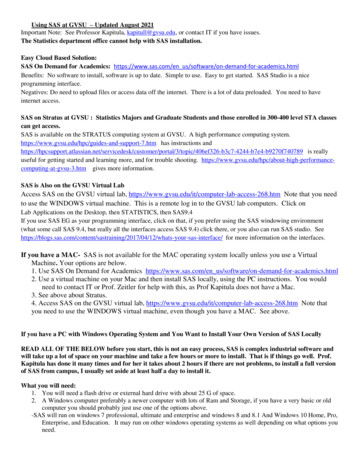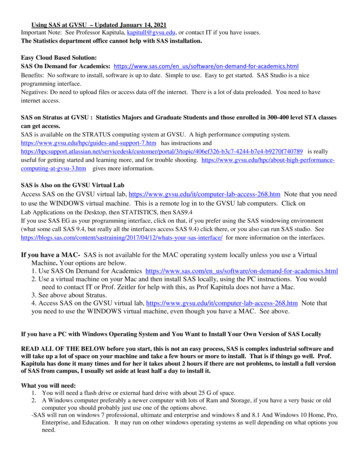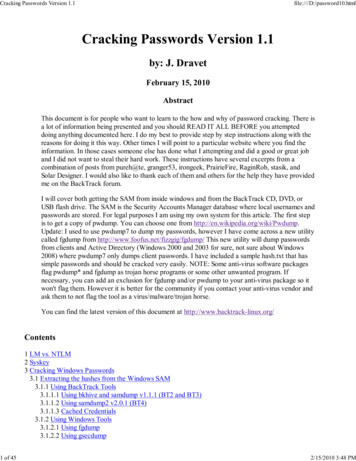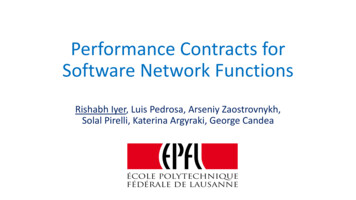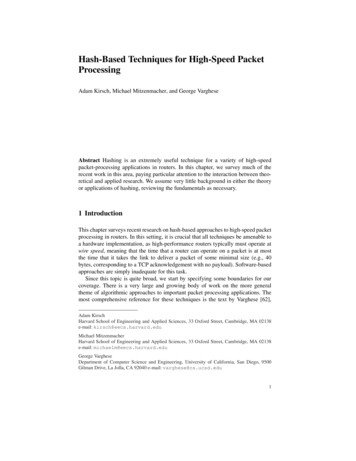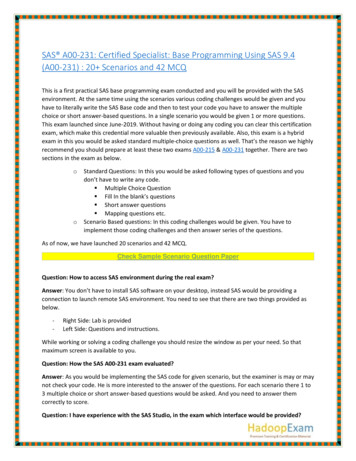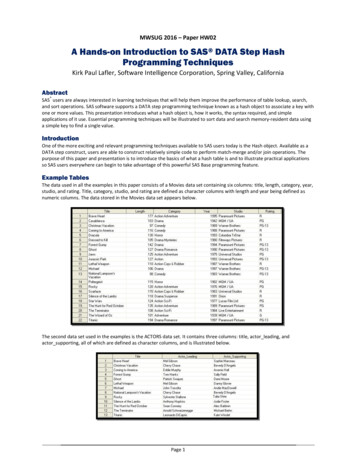
Transcription
MWSUG 2016 – Paper HW02A Hands-on Introduction to SAS DATA Step HashProgramming TechniquesKirk Paul Lafler, Software Intelligence Corporation, Spring Valley, CaliforniaAbstract SAS users are always interested in learning techniques that will help them improve the performance of table lookup, search,and sort operations. SAS software supports a DATA step programming technique known as a hash object to associate a key withone or more values. This presentation introduces what a hash object is, how it works, the syntax required, and simpleapplications of it use. Essential programming techniques will be illustrated to sort data and search memory-resident data usinga simple key to find a single value.IntroductionOne of the more exciting and relevant programming techniques available to SAS users today is the Hash object. Available as aDATA step construct, users are able to construct relatively simple code to perform match-merge and/or join operations. Thepurpose of this paper and presentation is to introduce the basics of what a hash table is and to illustrate practical applicationsso SAS users everywhere can begin to take advantage of this powerful SAS Base programming feature.Example TablesThe data used in all the examples in this paper consists of a Movies data set containing six columns: title, length, category, year,studio, and rating. Title, category, studio, and rating are defined as character columns with length and year being defined asnumeric columns. The data stored in the Movies data set appears below.The second data set used in the examples is the ACTORS data set. It contains three columns: title, actor leading, andactor supporting, all of which are defined as character columns, and is illustrated below.Page 1
An Introduction to SAS Hash Programming Techniques, continuedMWSUG 2016What is a Hash Object?A hash object is a data structure that contains an array of items that are used to map identifying values, known as keys (e.g.,employee IDs), to their associated values (e.g., employee names or employee addresses). As implemented, it is designed as aDATA step construct and is not available to any SAS PROCedures. The behavior of a hash object is similar to that of a SAS arrayin that the columns comprising it can be saved to a SAS table, but at the end of the DATA step the hash object and all itscontents disappear.How Does a Hash Object Work?A hash object permits table lookup operations to be performed considerably faster than other available methods found in theSAS system. Unlike a DATA step merge or PROC SQL join where the SAS system repeatedly accesses the contents of a tablestored on disk to perform table lookup operations, a hash object reads the contents of a data set into memory once allowingthe SAS system to repeatedly access it, as necessary. Since memory-based operations are typically faster than their disk-basedcounterparts, users generally experience faster and more efficient table lookup operations. The following diagram illustratesthe process of performing a table lookup using the Movie Title (i.e., key) in the MOVIES data set matched against the MovieTitle (i.e., key) in the ACTORS data set to return the ACTOR LEADING and ACTOR SUPPORTING information.MOVIES Data SetACTORS Data SetTITLEBrave HeartTITLEBrave HeartACTOR LEADINGMel GibsonACTOR SUPPORTINGSophie Marceau.Christmas VacationChevy ChaseBeverly D’AngeloChristmas VacationComing to AmericaEddie MurphyArsenio HallComing to America.Figure 1. Table Lookup Operation with Simple KeyAlthough one or more hash tables may be constructed in a single DATA step that reads data into memory, users mayexperience insufficient memory conditions preventing larger tables from being successfully processed. To alleviate this kind ofissue, users may want to load the smaller tables as hash tables and continue to sequentially process larger data sets containinglookup keys.Hash Object SyntaxUsers with DATA step programming experience will find the hash object syntax relatively straight forward to learn and use.Available in all operating systems running SAS 9 or greater, the hash object is called using methods. The syntax for calling amethod involves specifying the name of the user-assigned hash table, a dot (.), the desired method (e.g., operation) by name,and finally the specification for the method enclosed in parentheses. The following example illustrates the basic syntax forcalling a method to define a key.HashTitles.DefineKey (‘Title’);where:HashTitles is the name of the hash table, DefineKey is the name of the called method, and ‘Title’ is the specification beingpassed to the method.Hash Object MethodsThe author has identified twenty six (26) known methods which are alphabetically displayed, along with their description, in thefollowing table.Page 2
An Introduction to SAS Hash Programming Techniques, continuedMWSUG 2016MethodDescriptionADDAdds data associated with key to hash object.CHECKChecks whether key is stored in hash object.CLEARRemoves all items from a hash object without deleting hash object.DEFINEDATADefines data to be stored in hash object.DEFINEDONESpecifies that all key and data definitions are complete.DEFINEKEYDefines key variables to the hash object.DELETEDeletes the hash or hash iterator object.EQUALSDetermines whether two hash objects are equal.FINDDetermines whether the key is stored in the hash object.FIND NEXTThe current list item in the key’s multiple item list is set to the next item.FIND PREVThe current list item in the key’s multiple item list is set to the previous item.FIRSTReturns the first value in the hash object.HAS NEXTDetermines whether another item is available in the current key’s list.HAS PREVDetermines whether a previous item is available in the current key’s list.LASTReturns the last value in the hash object.NEXTReturns the next value in the hash object.OUTPUTCreates one or more data sets containing the data in the hash object.PREVReturns the previous value in the hash object.REFCombines the FIND and ADD methods into a single method call.REMOVERemoves the data associated with a key from the hash object.REMOVEDUPRemoves the data associated with a key’s current data item from the hash object.REPLACEReplaces the data associated with a key with new data.REPLACEDUPReplaces data associated with a key’s current data item with new data.SETCURSpecifies a starting key item for iteration.SUMRetrieves a summary value for a given key from the hash table and stores the value to aDATA step variable.SUMDUPRetrieves a summary value for the key’s current data item and stores the value to a DATAstep variable.Page 3
An Introduction to SAS Hash Programming Techniques, continuedMWSUG 2016Sort with a Simple KeySorting is a common task performed by SAS users everywhere. The SORT procedure is frequently used to rearrange the order ofdata set observations by the value(s) of one or more character or numeric variables. A feature that PROC SORT is able to do isreplace the original data set or create a new ordered data set with the results of the sort. Using hash programming techniques,SAS users have an alternative to using the SORT procedure. In the following example, a user-written hash routine is constructedin the DATA step to perform a simple ascending data set sort. As illustrated, the metadata from the MOVIES data set is loadedinto the hash table, a DefineKey method specifies an ascending sort using the variable LENGTH as the primary (simple) key, aDefineData method to select the desired variables, an Add method to add data to the hash object, and an Output method todefine the data set to output the results of the sort to.Hash Code with Simple KeyLibname mydata ‘e:\workshops\workshop data’ ;data null ;if 0 then set mydata.movies;/* load variable properties into hash tables */if n 1 then do;declare Hash HashSort (ordered:’a'); HashSort.DefineKey (‘Length'); HashSort.DefineData (‘Title‘,/* declare the sort order for hash *//* identify variable to use as simple key rt.DefineDone ();/* identify columns of data *//* complete hash table definition */end;set mydata.movies end eof; HashSort.add (); if eof then HashSort.output(dataset:sorted movies);/* add data with key to hash object *//* write data using hashHashSort */run;As illustrated in the following SAS Log results, SAS processing stopped with a data-related error due to one or more duplicatekey values. As a result, the output data set contained fewer results (observations) than expected.SAS Log ResultsLibname mydata ‘e:\workshops\workshop data’ ;data null ;if 0 then set mydata.movies;/* load variable properties into hash tables */if n 1 then do;declare Hash HashSort (ordered:'a'); /* declare the sort order for hash */HashSort.DefineKey ('Length'); /* identify variable to use as simple key */HashSort.DefineData ('Title','Length','Category','Rating'); /* identify columns of data */HashSort.DefineDone (); /* complete hash table definition */end;Page 4
An Introduction to SAS Hash Programming Techniques, continuedMWSUG 2016SAS Log Results (Continued)set mydata.movies end eof;HashSort.add ();/* add data with key to hash object */if eof then HashSort.output(dataset:'sorted movies'); /* write data using hashHashSort */run;ERROR: Duplicate key.NOTE: The data set WORK.SORTED MOVIES has 21 observations and 4 variables.NOTE: The SAS System stopped processing this step because of errors.NOTE: There were 22 observations read from the data set MYDATA.MOVIES.Sort with a Composite KeyTo resolve the error presented in the previous example, an improved and more uniquely defined key is specified. The simplestway to prevent a conflict consisting of duplicate is to add a secondary variable to the key creating a composite key. Thefollowing code illustrates constructing a composite key with a primary variable (LENGTH) and a secondary variable (TITLE) toreduce the prospect of producing a duplicate key value from occurring (collision).Hash Code with Composite Keydata null ;if 0 then set mydata.movies;/* load variable properties into hash tables */if n 1 then do;declare Hash HashSort (ordered:’a'); /* declare the sort order for HashSort */ HashSort.DefineKey (‘Length', ‘Title’); /* identify variables to use ascomposite key */HashSort.DefineData ’);/* identify columns of data */HashSort.DefineDone (); /* complete HashSort table definition */end;set mydata.movies end eof; HashSort.add (); /* add data with key to HashSort table */ if eof then HashSort.output(dataset:sorted movies);/* write data using hashHashSort */run;SAS Log ResultsAs shown on the SAS Log results, the creation of the composite key of LENGTH and TITLE is sufficient enough to form a uniquekey enabling the sort process to complete successfully with 22 observations read from the MOVIES data set, 22 observationswritten to the SORTED MOVIES data set, and zero conflicts (or collisions).Page 5
An Introduction to SAS Hash Programming Techniques, continuedMWSUG 2016data null ;if 0 then set mydata.movies; /* load variable properties into hash tables */if n 1 then do;declare Hash HashSort (ordered:'a'); /* declare the sort order for HashSort */HashSort.DefineKey ('Length', ‘Title’); /* identify variable to use ascomposite key */HashSort.DefineData ('Title','Length','Category','Rating'); /* identify columns of data */HashSort.DefineDone (); /* complete HashSort table definition */end;set mydata.movies end eof;HashSort.add (); /* add data using key to HashSort table */if eof then HashSort.output(dataset:'sorted movies'); /* write data usingHashSort */run;NOTE: The data set WORK.SORTED MOVIES has 22 observations and 4 variables.NOTE: There were 22 observations read from the data set MYDATA.MOVIES.Search and Lookup with a Simple KeyBesides sorting, another essential action frequently performed by users is the process of table lookup or search. The hashobject as implemented in the DATA step provides users with the necessary tools to conduct match-merges (or joins) of two ormore data sets. Data does not have to be sorted or be in a designated sort order before use as it does with the DATA stepmerge process. The following code illustrates a hash object with a simple key (TITLE) to merge (or join) the MOVIES and ACTORSdata sets to create a new dataset (MATCH ON MOVIE TITLES) with matched observations.data match on movie titles(drop rc); if 0 then set mydata.moviesmydata.actors;/* load variable properties into hash tables */if n 1 then do; declare Hash MatchTitles (dataset:'mydata.actors'); /* declare the nameMatchTitles for hash */ MatchTitles.DefineKey ('Title'); /* identify variable to use as key */MatchTitles.DefineData (‘Actor Leading’,‘Actor Supporting’); /* identify columns of data */MatchTitles.DefineDone (); /* complete hash table definition */end;set mydata.movies; if MatchTitles.find(key:title) 0 then output; /* lookup TITLE in MOVIES tableusing MatchTitles hash */run;Page 6
An Introduction to SAS Hash Programming Techniques, continuedMWSUG 2016ResultsThe match-merge (or join) process is illustrated using the following diagram.MoviesActorsMatch on Movies TitlesTransposing with the TRANSPOSE ProcedureIn the paper; SAS on a Shingle, Flippin with Hash (2012); Miller and Lafler illustrate two key points: 1) how PROC TRANSPOSE isused for converting SAS data set structures and 2) how hash programming techniques are used to emulate the PROCTRANSPOSE process. The objective was to demonstrate the programming techniques and select hash methods that were usedto successfully create a transposed data set. For those unfamiliar or with limited experience using PROC TRANSPOSE, the SASBase procedure gives SAS users a convenient way to transpose (or restructure) any SAS data set structure. Popular uses forPROC TRANSPOSE include: Converting the observations of a data set structure to variables, sometimes referred to as changing a vertical (long orthin) data structure to a horizontal (wide or fat) data structure; Converting the variables of a data set structure to observations, sometimes referred to as changing a horizontal (wideor fat) data structure to a vertical (long or thin) data structure.Although experienced SAS users may use any number of approaches in lieu of the TRANSPOSE procedure to restructure a dataset, these alternate techniques can require more time for programming, testing and debugging. The PROC TRANSPOSE syntaxto restructure (or transpose) selected variables into observations is shown, below. After sorting the MOVIES data set inascending order by TITLE, PROC TRANSPOSE then accesses the sorted MOVIES data set. The BY statement tells PROCTRANSPOSE to create BY-groups for the variable TITLE. The VAR statement specifies the variables, RATING and LENGTH, totranspose into observations. The result of the transpose process is then written to a data set called, Transposed Movies.Page 7
An Introduction to SAS Hash Programming Techniques, continuedMWSUG 2016PROC TRANSPOSE Code:libname mydata "e:\workshops\workshop data" ;proc sort data mydata.moviesout sorted movies ;by title ;run ;proc transpose data sorted moviesout transposed movies ;by title ;var rating length ;run;The resulting Transposed Movies data set from running the TRANSPOSE procedure, below, contains three variables: TITLE,NAME and COL1. With closer inspection, the data set contains duplicate TITLE values (observations), a distinct NAMEvalue for “Rating” in the first observation of COL1 and a distinct NAME value for “Length” in the second observation of COL1for each BY-group.Transposed Movies Data Set created with PROC TRANSPOSEPage 8
An Introduction to SAS Hash Programming Techniques, continuedMWSUG 2016Transposed Movies Data Set (continued)Transposed Movies Data Set created with PROC TRANSPOSE (continued)Transposing with the DATA Step Hash MethodMy objective for using Hash methods in creating a restructured transposed data set is to emulate was is created with theTRANSPOSE procedure. We’ll begin with the statement, “DATA Hash Long Movies”, because the application of Hash methodsis currently only available in a DATA step. The next statement, “IF 0 THEN SET MYDATA.MOVIES” tells SAS to load variableproperties into the hash object located in real memory. The DECLARE HASH statement provide a name to the hash objectbeing created in memory as ‘Hash movies’, the name of the input data set, and how the data is ordered. The “DECLAREHITER” statement defines and initializes the hash object for traversing the object in memory. The DEFINEKEY methodidentifies the variable (or variables) to use as the key. The DEFINEDATA method informs SAS what variables to read into thehash object in memory (in our case all variables not removed with the DROP (or KEEP ) data set option). The DEFINEDONEmethod completes the hash table definition. The FIRST() method tells SAS to return the first value stored in the definedhash object. The DO WHILE loop iterates repeatedly as long as there is data stored in the hash object. The LINKOUTLONG statement tells SAS to execute the OUTLONG subroutine. The NEXT() method tells SAS to return the next valuefrom the defined hash object.The STOP statement tells SAS to terminate the DATA step.libname mydata ‘e:\workshops\workshop data’ ; data hash long movies (drop rc Rating Length) ; if 0 then set mydata.movies(keep Title Rating Length) ;if n 1 then do ; declare Hash Hash ) ; declare Hiter Hi movies ('Hash movies') ;Hash movies.DefineKey ('Title') ;Hash movies.DefineData (‘Title’, ‘Rating’, ‘Length’) ;Hash movies.DefineDone () ;end ; rc Hi movies.first() ; do while (rc 0) ; link outlong ;rc Hi movies.next() ;end;stop ;return ;Page 9
An Introduction to SAS Hash Programming Techniques, continuedMWSUG 2016 outlong: ;Title ;Label 'Rating' ;Value Rating ;output hash long movies ;Title ;Label 'Length' ;Value Length ;output hash long movies ;return ;run ;The resulting Hash Long Movies data set created with the Hash methods, below, contains three variables: TITLE, LABEL andVALUE. As with the transposed data set created earlier, this data set contains duplicate TITLEs, a distinct LABLE value for“Rating” in the first observation of VALUE and for “Length” in the second observation of VALUE for each BY-group.Hash Long Movies Data Set created with Hash MethodsPage 10
An Introduction to SAS Hash Programming Techniques, continuedMWSUG 2016Hash Long Movies Data Set (continued)Hash Long Movies Data Set created with Hash Methods (continued)ConclusionUsers have a powerful hash DATA-step construct to sort data, search data sets, perform table lookup operations, and transposedata sets in the SAS system. This paper introduced the basics of what a hash table is, how it works, the basic syntax, and itspractical applications so SAS users everywhere can begin to take advantage of this powerful memory-based programmingtechnique to improve the performance of sorts, searches, table lookup operations, and transposes.ReferencesDorfman, Paul, and Marina Fridman (2010). "Black Belt Hashigana," Proceedings of the 2010 North East SAS Users Group(SESUG) Conference.Dorfman, Paul and Peter Eberhardt (2010). "Two Guys on Hash," Proceedings of the 2010 South East SAS Users Group (SESUG)Conference. Dorfman, Paul (2009). "The SAS Hash Object in Action," Proceedings of the 2009 South East SAS Users Group (SESUG)Conference.Dorfman, Paul, Lessia S. Shajenko and Koen Vyverman (2008). "Hash Crash and Beyond," Proceedings of the 2008 SAS GlobalForum (SGF) Conference.Dorfman, Paul, and Koen Vyverman (2006). "DATA Step Hash Objects as Programming Tools," Proceedings of the Thirty-FirstSAS Users Group International Conference. Eberhardt, Peter (2011). “The SAS Hash Object: It’s Time to .find() Your Way Around,” Proceedings of the 2011 SAS GlobalForum (SGF) Conference. Lafler, Kirk Paul (2016). “An Introduction to SAS Hash Programming Techniques,” Proceedings of the 2016 South East SAS UsersGroup (SESUG) Conference. Lafler, Kirk Paul (2016). “An Introduction to SAS Hash Programming Techniques,” Proceedings of the 2016 Iowa SAS UsersGroup (IASUG) Conference. Lafler, Kirk Paul (2015). “An Introduction to SAS Hash Programming Techniques,” Proceedings of the 2015 South Central SASUsers Group (SCSUG) Conference. Lafler, Kirk Paul (2011). “An Introduction to SAS Hash Programming Techniques,” Proceedings of the 2011 South East SAS UsersGroup (SESUG) Conference. Lafler, Kirk Paul (2011). “An Introduction to SAS Hash Programming Techniques,” Proceedings of the 2011 PharmaSUGConference. Lafler, Kirk Paul (2011). “An Introduction to SAS Hash Programming Techniques,” San Diego SAS Users Group (SANDS) Meeting,thFebruary 16 , 2011. Lafler, Kirk Paul (2010). “An Introduction to SAS Hash Programming Techniques,” Bay Area SAS (BASAS) Users Group Meeting,thDecember 7 , 2010.Page 11
An Introduction to SAS Hash Programming Techniques, continuedMWSUG 2016 Lafler, Kirk Paul (2010). “An Introduction to SAS Hash Programming Techniques,” Proceedings of the 2010 South Central SASUsers Group (SCSUG) Conference. Lafler, Kirk Paul (2010). “An Introduction to SAS Hash Programming Techniques,” Awarded “Best” Contributed Paper,Proceedings of the 2010 Western Users of SAS Software (WUSS) Conference.Lafler, Kirk Paul (2010). “DATA Step and PROC SQL Programming Techniques,” Ohio SAS Users Group (OSUG) One-DayConference, Software Intelligence Corporation, Spring Valley, CA, USA.Lafler, Kirk Paul (2010). “Exploring Powerful Features in PROC SQL,” SAS Global Forum (SGF) Conference, Software IntelligenceCorporation, Spring Valley, CA, USA.Lafler, Kirk Paul (2009). “DATA Step and PROC SQL Programming Techniques,” South Central SAS Users Group (SCSUG) 2009Conference, Software Intelligence Corporation, Spring Valley, CA, USA.Lafler, Kirk Paul (2009). “DATA Step versus PROC SQL Programming Techniques,” Sacramento Valley SAS Users Group 2009Meeting, Software Intelligence Corporation, Spring Valley, CA, USA.Loren, Judy and Richard A. DeVenezia (2011). "Building Provider Panels: An Application for the Hash of Hashes," Proceedings ofthe 2011 SAS Global Forum (SGF) Conference.Loren, Judy (2006). "How Do I Love Hash Tables? Let Me Count The Ways!," Proceedings of the Nineteenth Northeast SAS UsersGroup Conference.Miller, Ethan and Kirk Paul Lafler (2012), “SAS on a Shingle, Flippin with Hash,” Proceedings of the 2012 Western Users of SASSoftware (WUSS) Conference Proceedings, SRI International, Menlo Park, CA, and Software Intelligence Corporation, SpringValley, CA, USA.Muriel, Elena (2007). “Hashing Performance Time with Hash Tables,” Proceedings of the 2007 SAS Global Forum (SGF)Conference. Parman, Bill (2006). “How to Implement the SAS DATA Step Hash Object,” Proceedings of the 2006 Southeast SAS Users GroupConference. Ray, Robert and Jason Secosky (2008). “Better Hashing in SAS 9.2,” Proceedings of the Second Annual SAS Global Forum (SGF)Conference, SAS Institute Inc., Cary, NC, USA.Secosky, Jason (2007). “Getting Started with the DATA Step Hash Object,” Proceedings of the 2007 SAS Global Forum (SGF)Conference, SAS Institute Inc., Cary, NC, USA.AcknowledgmentsThe author thanks Dave Foster and Chuck Kincaid, Hands-On Workshops Section Chairs, for accepting my abstract and paper;Richann Watson, MWSUG 2016 Academic Chair; Adrian Katschke, MWSUG 2016 Operations Chair; the MidWest SAS UsersGroup (MWSUG) Executive Board; and SAS Institute for organizing and supporting a great conference!Trademark CitationsSAS and all other SAS Institute Inc. product or service names are registered trademarks or trademarks of SAS Institute Inc. in theUSA and other countries. indicates USA registration. Other brand and product names are trademarks of their respectivecompanies.About The AuthorKirk Paul Lafler is an entrepreneur, consultant and founder of Software Intelligence Corporation, and has been using SAS since1979. Kirk is a SAS Certified Professional, provider of IT consulting services, advisor and professor at UC San Diego Extension andeducator to SAS users around the world, mentor, and emeritus sasCommunity.org Advisory Board member. As the author of sixbooks including Google Search Complete (Odyssey Press. 2014) and PROC SQL: Beyond the Basics Using SAS, Second Edition(SAS Press. 2013); Kirk has written hundreds of papers and articles; been an Invited speaker and trainer at hundreds of SASInternational, regional, special-interest, local, and in-house user group conferences and meetings; and is the recipient of 23“Best” contributed paper, hands-on workshop (HOW), and poster awards.Comments and suggestions can be sent to:Kirk Paul LaflerSenior SAS Consultant, Application Developer, Data Analyst, Educator and AuthorSoftware Intelligence CorporationE-mail: KirkLafler@cs.comLinkedIn: http://www.linkedin.com/in/KirkPaulLaflerTwitter: @sasNerdPage 12
An Introduction to SAS Hash Programming Techniques, continued MWSUG 2016 Page 3 Method Description ADD Adds data associated with key to hash object. CHECK Checks whether key is stored in hash object. CLEAR Removes all items from a hash object without deleting hash object. DEFINEDATA Defines data to be stored in hash object. DEFINEDONE Specifies that all key and data definitions are complete.
